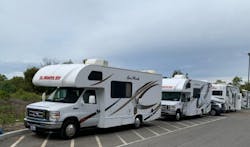The Claude “Bud” Lewis Carlsbad Desalination Plant (“CDP”), which recently celebrated its five-year anniversary, produces 50 million gallons of fresh water per day. It now accounts for one-third of all water generated in San Diego county.
When the coronavirus pandemic hit in early 2020, the facility needed to completely overhaul its workflow in a matter of weeks. CDP not only managed to cut its staffing, implement remote monitoring, and keep its operators fully sheltered onsite — it also did so without any drops in productivity.
Adjusting to COVID-19
The facility rapidly worked to make its staff as lean as possible — but also while maintaining steady production. Although changes needed to occur quickly, the CDP is subject to a wide range of regulations and compliance requirements: any modifications to operations needed to be collaborated and approved by the San Diego County Water Authority as well as state regulators:
In March 8, 2020, an “Essentials Only Policy” policy launched, limiting entrance to the premises of the facility. Then, in March 19, 2020, the facility initiated its “COVID-19 Plant Shelter-in-Place Operation Plan” ahead of the Calif. governor’s mandate:
- A group of 10 critical employees volunteered to shelter for 21 days on-site while running all maintenance, operation, and lab work.
- Managers and experts would provide support and guidance remotely
SPECIAL REPORT: Critical Water Plant Workers Self-Isolate on Site
Changes to Staffing
Under normal circumstances, 40 IDE employees would be on-site in a given day. Operator shift structure would be comprised of three operators covering 12-hour shifts.
With the new policies, two operators would instead cover the 12-hour shifts, with more work allocated to lab technicians and maintenance support. Lab employees would continue supporting all monitoring requirements over 12-hour workdays, while also conducting routine sampling.
Maintenance work and priorities also needed to be redefined. With the new plan in place, the team included as few on-site personnel as was feasible: an electrician, mechanical technicians, and general labor, working seven days a week in eight-hour shifts and four-hours of on-call availability.
Because of the unique circumstances created by the lockdown, a chief operator provided remote monitoring and support around the clock. All-teams video meetings quickly became a daily routine — these meetings helped evaluate performance and workplans, but also helped keep a constant finger on the pulse of team morale.
The remote team also acted as a potential standby, which could replace the onsite team whenever necessary. These remote employees worked in the off-site warehouse as needed, while also providing remote monitoring and on-demand guidance from their homes.
To keep the onsite staff well informed on the latest best practices or developments, the remote team also offered remote training and e-learning.
Supporting Employees
Twenty-one days of onsite cycles required all the necessary logistics to be addressed ahead of time, including proper accommodation, food and other basic services. Each employee was supplied with his or her own private RV for lodging in the plant’s parking lot, providing the staff a quiet space for much-needed rest and recharge during downtime.
Food supply was managed through online orders, with outside support provided by management as needed. Purchased and installed for their use, volunteers also had access to washers and dryers, the plant’s breakroom, cafeteria and showers, with the aim to provide all employees maximum comfort in between shifts. WW
About the Author
Gilad Cohen
Gilad Cohen, appointed in 2017 to CEO of IDE Americas, joined IDE in 2009 as corporate business development manager, responsible for investment evaluations and M&A activity, as well as development of new business platforms in target markets. Prior to IDE, he held the position as senior consultant for one of Israel's leading management consulting firms on business competitive and corporate strategy, where he successfully led business development in South East Asia and Central Eastern Europe. Cohen holds a B.Sc. in Computer Sciences and an MBA majoring in marketing management (Magna Cum Laude), both from the Hebrew University in Jerusalem.

